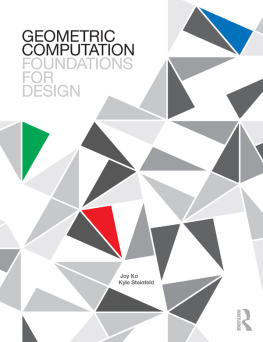The current state-of-the art in Human Computing all too often involves large batches of some mundane but nevertheless computationally intractable problem (find the blue dot; read the words; fit the puzzle pieces); and is undertaken by a developer who realizes that large numbers of people might by various means be induced to each perform modest numbers of these tasks before getting bored and moving on to something else. And if enough people can do enough of these tasks useful things can be accomplished.
But this sectionand this Handbook generallyseeks to encourage thinking beyond such a Virtual Sweatshop model; and to replace it with the aspiration to create massively large scale thinking systems, systems which might some day be used to address problems at an order of complexity beyond the competence of any individual person.
Moving in this directionopening this avenue of investigationinvolves giving thought to some basic ideas: what is computing? What is thinking? What is information? This direction benefits from ideas about the nature of communication; about complex systems and the emergent properties of such systems; about control of complex systems. Ideas about networks, about collaboration, about minds, about ecosystems, about cultureand a great many other topics.
In many of these instances, the best and deepest thought has been done in domains which might on their face seem distant from software development: Epistemology, Psychology, Cybernetics, Biology, Anthropology, Economics, and so on.
This chapter is not in any sense a comprehensive collection of Foundational concepts; it is more a diverse set of interesting tidbits, a taste. We aspire to continue an ongoing flow of such illuminating ideas as a regular feature in a forthcoming Human Computation journal. But the chapters that follow embody some introductory discussions:
Patterns of Connection (Matthew Blumberg) Drawing on ideas from Marvin Minsky, this chapter explores the nature of Mind, and the extent to which Mind emerges from particular patterns of connection. This is used to illustrate the concept of Cognitive Architecture, which is proposed as a central concept in Human Computing.
The History of Human Computation (David Alan Grier) The idea of organizing groups of people to perform cognitive work precedes computers and the Internet. This fascinating chapter traces the origins of these ideas back to Charles Babbages early analysis of factories at the dawn of the industrial era.
Biological Networks as Models for Human Computation (Melanie Moses, Tatiana P. Flanagan, Kenneth Letendre, G. Matthew Fricke) Notions of Mind have traditionally reflected to the technology of the day; advancing technology has lead, curiously, to ever more powerful metaphors. At various points, the mind was a garden, a factory, a computer. Recent trends return to biology: this chapter explores biological networks as an instructive model.
From Neural to Human Communication (Linda Larson-Prior) If one wants to learn to organize a thinking system, a natural place to look to for guidance is the brain. This chapter considers both neural and human communication in order to better understand the potential for computation as an emergent behavior of a system.
Pathology in Information Systems (Pietro Michelucci, Matthew Blumberg) Mental Illness in Humans can be viewed as a specific case of the more general phenomena of pathology in information systems. Thus Human Computing systemsand groups of people generallymay become pathological: large scale political failures like the Inquisition or Fascism being an example; as potentially are smaller scale systems like dysfunctional families. This chapter speculatively explores these issues, proposing this as a domain for future inquiry, so as to develop means to prevent, diagnose, and repair such systemic pathologiesi.e., to develop means to debug complex systems.
Information Theoretic Analysis and Human Computation (Carlos Gershenson) This chapter introduces concepts of Information Theory in the context of Human Computing systems. What is Information? What is Computing? How does one talk about Networks?
Epistemological Issues in Human Computation (Helmut Nechansky) The field of Epistemology brings to bear centuries of thought about the nature of Knowledge. This chapter takes as a start the view of Knowledge as an individual model of an external world, and explores the use of such models for decision-making. Implications for Human Computing are considered.
Synthesis and Taxonomy of Human Computation (Pietro Michelucci) As this Foundations section demonstrates, a wide range of fields contribute to the growing body of work in human computation. Each field, though, has its own set of concepts and associated words (e.g., social computing, distributed thinking, crowdsourcing, etc.) This chapter draws from these various disciplinesand from the diverse contributions found in this volumein an effort to organize the concepts and provide a common conceptual framework.
Background
My interest in Human Computation described here as Distributed Thinking dates back to 2008 and the FIFA World Cup final. The truth is (being American) I didnt watch. I only read about it the next day. It was quite a match, apparently eventually won 1-0, on a 73rd-minute goal by Wayne Rooney of Manchester United. But what was most notable in the coverage to me was the comment that the match had been watched, live, by 700 million people.
A soccer game being about 90 min long, this amounts to more than a billion hours of human attention focused on a bouncing ball. Thats about 120,000 person-years of attention compressed into 90 min.
Which raised the question: what could be done with all that cognition? Could it be harnessed for constructive purposes? What knowledge and tools and methods would be required?
Crowdsourcing
A number of web-based projects have emerged which draw on the aggregated intellectual skills of large numbers of people over the Internet. These projects represent the state of the art in Human Computationexciting efforts to harness many minds in order to do intellectual work that would otherwise be impossible. A few key examples follow (there are of course many others):













